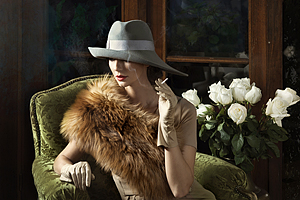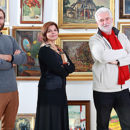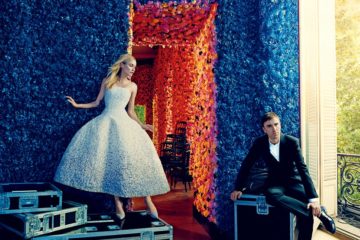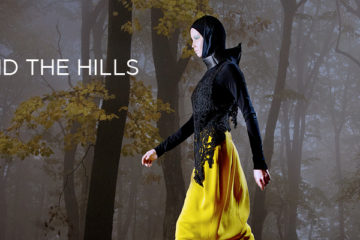
UNTIL MIDNIGHT
Gabriela Dumitran’s creations surprise by the simplicity of their theme, the elegance of their shape and the consistency of their source of inspiration. Her passion for hats, details and beauty has made her name one of the most respected brands in the world of Romanian accessory design.
There’s much talk in Romania about how, in the world of fashion, some trades have gone almost completely extinct. One of them is that of hat designer…
The fact that people talk about this is a good sign, it’s an indication that people are starting to return to the real values that have been forgotten during the economic boom – when everything was happening so fast and there was a real lack of substance.
In full recession, under the overwhelming assault of the big corporations flooding the market with millions upon millions of copies of the same model, Gabriela Dumitran is building, slowly but steadily, her own hat business. How and more importantly why did this adventure come into being?
I discovered the thrills of this profession back in 2008 and I have to say it was love at first sight. But it’s a long way from passion and pleasure to building a business, one that requires a lot of time and effort. To answer your question, I believe in people’s need to be unique, distinct individuals, to express themselves, their personality in a way that’s real, and my strong belief is that the hat can do this for them.
I beg to disagree with you, though, on the expressed reality: there have always been a second and third line that breathed new air into the market. And I’m thinking here about the small businesses that have a different set of advantages on the market than the big corporations. It’s true – as we can see in our everyday life – that there’s not many of them. But in countries with a tradition in this respect (Italy, France, Spain), there are plenty examples of such little great companies – small companies with high added value.
Back on the subject of the hat and its return in the designers’ and buyers’ attention… This hasn’t happened over night. I think that what’s happening today is the direct result of everything that has been done during the last 15-16 years. 1996 was a particularly important year for the industry: Chanel took over Maison Michel and Stephen Jones was invited by John Galliano to work for Dior. Chanel basically saved from bankruptcy the oldest hat parlour in Paris, and Galliano quite literally set the stage and placed on it the person that now signs the hats for Dior, Comme des Garçons, Emanuel Ungaro, Loewe, etc. But this is only one side of this phenomenon. Young buyers have really warmed to this accessory, influenced by such celebrities as Lady Gaga, Justin Timberlake, Rihanna, Sarah Jessica Parker, but also by the street style blogs that frequently suggest outfits including hats. I should also mention here some mass market companies’ decision to work with well known hat makers, for instance the collaboration between The Gap and Albertus Swanepoel, one of the most renowned hat makers in New York (recent years has seen him work with the likes of Marc Jacobs, Proenza Schouler, Carolina Herrera, Diane Von Furstenberg, DKNY, etc).
An appropriate hat can perfectly round up a certain look, but it can also make you into a distinctive person, give you a certain unique air. What does wearing a hat mean to you?
Wearing a hat means standing up for what you really are.
What’s the difference between a perfect hat and one that’s… simply ridiculous? How far can creativity go before the result becomes “unfriendly”?
It’s all a matter of aesthetics. It only gets ridiculous when there’s a big discrepancy between the person, the outfit, the attitude and the hat. As long as that’s not the case, creativity can “go” anywhere, it can take you as far as you like as long as the hat is wearable.
Let’s get back to your workshop. One visit to this universe can really be a cultural experience. How did you manage to equip your workshop with the best, most professional utensils, where did you find them?
A lot of effort went into fitting the workshop with professional equipment. I basically went through any and all possible means of information in order to find the producers with the best expertise in the field. In the end, the experiment turned out to be a most beneficial one and right now I’m proud to be working with the best in the business. The producers I collaborate with hail from all over the world – from the U.K., the U.S., France, Italy and the Netherlands.
What are your favourite materials you like to use when making hats?
Wire and lace. They offer utmost freedom creativity-wise.
Silk flowers manufacturing is one of your shop’s “specialties”. Walk us through the process if you will, tell us how much time is required for making such a flower…
The procedures we implement in making the silk flowers are those used back in the XIX centuries. Hence, the execution time can be anywhere from four up to sixteen hours. The fabric is starched, each petal is drawn, painted over, cut out and processed individually, using specifically designed tools.
Any advice on caring for and, more importantly, cleaning felt hats?
Each hat should be kept in its own box, in a dry place. Felt hats can be cleaned using a natural bristles brush. One piece of advice: if your felt hat gets wet, don’t use a hair dryer on it. Allow it to dry out slowly, on its own.









